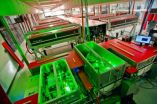(Press-News.org) When the HIV Prevention Trials Network (HPTN) 052 investigators released their landmark study results last year showing that treatment can reduce HIV transmission by 96% in serodiscordant couples, questions were raised about the cost of early antiretroviral therapy (ART) and if it should be universally implemented. Data presented today at the XIX International AIDS Conference in Washington, D.C. show that treatment as prevention is "very cost-effective". Using an HIV microsimulation model (CEPAC-International) to further expand analysis of HPTN 052 data, study investigators were able to project the clinical impact, costs, and cost-effectiveness of early ART. They found that this strategy increases survival, prevents costly opportunistic infections, averts early transmissions and is very cost-effective.
Commenting on the findings, Rochelle Walensky, MD, MPH, Associate Director of the Program in Epidemiology and Outcomes Research at the Harvard Center for AIDS Research said, "Early ART is a triple winner: HIV-infected patients do better, their partners are protected and it is very cost-effective. Regardless of the country setting, over the long term treatment as prevention offers excellent return on investment across a wide range of assumptions about transmission and treatment effects."
The cost-effectiveness analysis was modeled in South Africa and India using trial-derived data. These two geographic locations were selected to illustrate how regional economic distinctions may, or may not, change the conclusions. Early ART was designated as very cost-effective or cost-effective if its cost-effectiveness ratio is < 1x or < 3x per capita GDP (GDPs: $8,100 [South Africa]; $1,400 [India]). In making the distinctions between cost-effective and cost-saving it is important to note that interventions need not save money to be cost-effective and worth implementing. Widely accepted international standards exist to help define when the health benefits of an intervention justify the additional costs. Using those standards, early ART is very cost-effective.
"This expanded analysis of the HPTN 052 study results provides more evidence that treatment as prevention is a strategy we can't afford to ignore," said Myron Cohen, MD, Co-Principal Investigator of HPTN, and the HPTN 052 Protocol Chair. "Clearly the results of the model indicate there is a great return on this important health investment."
HPTN 052 is an ongoing randomized clinical trial. A total of 1763 HIV serodiscordant couples were enrolled in HPTN 052 between April 2005 and May 2010.The study is being conducted at 13 sites in Africa, Asia, and North and South America. The majority of couples (97%) are heterosexual. All participants receive couples risk-reduction counseling, free condoms and testing and treatment for sexually transmitted infections Primary HIV care is also provided to the HIV-infected partner. Following the public announcement of results in May 2011, all HIV infected participants in the study were offered ART. All participants will continue to be followed until the planned study end in April 2015, to assess the durability of the prevention and clinical benefits.
###The release of the initial prevention and clinical study results of HPTN 052 in 2011 led to the revision of both World Health Organization (WHO) and U.S. treatment guidelines.
HPTN 052 is funded by the Division of AIDS (DAIDS)/U.S. National Institute of Allergy and Infectious Diseases (NIAID)/U.S. National Institutes of Health (NIH). HPTN 052 is conducted in collaboration with the AIDS Clinical Trials Group (ACTG). Study drugs are donated by Abbott Laboratories; Boehringer Ingelheim Pharmaceuticals, Inc.; Bristol-Myers Squibb; Gilead Sciences, Inc.; GlaxoSmithKline/ViiV Healthcare; and Merck & Co., Inc.
To learn more about the HIV Prevention Trials Network, visit www.hptn.org.
The HIV Prevention Trials Network (HPTN) is a worldwide collaborative clinical trials network that develops and tests the safety and efficacy of primarily non-vaccine interventions designed to prevent the acquisition and transmission of HIV. The HPTN research agenda is focused primarily on reduction of HIV transmission and acquisition through the use of ART for HIV-infected persons and ARVs as pre-exposure prophylaxis (PrEP) for HIV-negative persons for HIV prevention, reducing the impact of behavioral and biologic co-factors that increase risk of infection, treatment of substance use (particularly injection drug use), behavioral risk reduction interventions, and structural interventions. The highest priority of the HPTN is to develop and implement combination prevention strategies that demonstrate a significant and measurable reduction in HIV incidence in a variety of populations and epidemic settings.
Expanded analysis of HPTN 052 study results show cost-effectiveness of early treatment of HIV
2012-07-27
ELSE PRESS RELEASES FROM THIS DATE:
Computers can predict effects of HIV policies
2012-07-27
PROVIDENCE, R.I. [Brown University] — Policymakers struggling to stop the spread of HIV grapple with "what if" questions on the scale of millions of people and decades of time. They need a way to predict the impact of many potential interventions, alone or in combination. In two papers to be presented at the 2012 International AIDS Society Conference in Washington, D.C., Brandon Marshall, assistant professor of epidemiology at Brown University, will unveil a computer program calibrated to model accurately the spread of HIV in New York City over a decade and to make specific ...
Accelerated resolution therapy significantly reduces PTSD symptoms, researchers report
2012-07-27
July 27, 2012 (Tampa, FL) – Researchers at the University of South Florida (USF) College of Nursing have shown that brief treatments with Accelerated Resolution Therapy (ART) substantially reduce symptoms associated with post-traumatic stress disorder (PTSD) including, depression, anxiety, sleep dysfunction and other physical and psychological symptoms. The findings of this first study of ART appear in an on-line article published June 18, 2012 in the Journal Behavioral Sciences.
ART is being studied as an alternative to traditional PTSD treatments that use drugs or ...
The Olympics and bare feet: What have we learned?
2012-07-27
Ethiopian runner Abebe Bikila made history when he earned a gold medal at the 1960 Summer Olympics in Rome. His speed and agility won him the gold, but it was barefoot running that made him a legend.
When the shoes Bikila was given for the race didn't fit comfortably, he ditched them for his bare feet. After all, that's the way he had trained for the Olympics in his homeland.
Racing shoeless led to success for Bikila, and now, more than 50 years later, runners are continuing to take barefoot strides. Several Olympic runners have followed Bikila and nationally the trend ...
In-utero exposure to magnetic fields associated with increased risk of obesity in childhood
2012-07-27
In-utero exposure to relatively high magnetic field levels was associated with a 69 percent increased risk of being obese or overweight during childhood compared to lower in-utero magnetic field levels, according to a Kaiser Permanente study that appears in the current online version of Nature's Scientific Reports.
Researchers conducted the prospective cohort study, in which participating women in Kaiser Permanente's Northern California region carried a meter measuring magnetic field levels during pregnancy and 733 of their children were followed up to 13 years, to collect ...
Future of California high-speed rail looks green
2012-07-27
Berkeley — A new analysis gives Californians good reason to be optimistic about the green credentials of the state's proposed high-speed rail project, due to begin construction in 2013 thanks to funding recently approved by state legislators.
Arpad Horvath at the University of California, Berkeley, and Mikhail Chester at Arizona State University compared the future sustainability of California high-speed rail with that of competing modes of transportation, namely automobile and air travel. They determined that, in terms of energy consumption and greenhouse gas emissions, ...
Breakthrough treatment reduces post-surgical scarring for glaucoma patients
2012-07-27
Scientists at the Singapore Eye Research Institute (SERI) and Nanyang Technological University (NTU) have developed an innovative way to combat post-surgical scarring for glaucoma patients.
A clinical trial has shown that the use of a new drug delivery method has resulted in 40 per cent fewer injections needed by glaucoma patients to prevent scarring after surgery. This also means fewer hospital visits for these patients in future.
Glaucoma, a disease characterised by a build-up of pressure in the eye, is a major cause of blindness worldwide. It affects about 3 per ...
UK welfare reform 'uninspiring' and adding to economic woes and inequality
2012-07-27
London (July 27 2012). The terms of welfare reform and Labor market activation in the UK need to be re-set, according to a senior university policy expert Andrew Jones, director of the Local Economy Policy Unit at London South Bank University, and editor of Local Economy, published by SAGE. He warns that the UK Government's predominant philosophy towards the UK Welfare state accepts and supports social hierarchy and defends privilege. This, he argues, is re-creating and strengthening the conditions that provoked the 2007 economic crisis.
"The rapid movement along this ...
Turbulent relationship among massive stars
2012-07-27
An international team of researchers from the USA and Europe including from the University of Bonn under the direction of Dr. Hugues Sana (University of Amsterdam) has discovered that the most massive stars in the universe don't spend their lives in space as singles as was previously thought. More than two-thirds orbit a partner star. "The orbit paths of the stars are very close together so that the region around these stars is turbulent and by far not as calm as previously thought," says Professor Norbert Langer from the University of Bonn. What happens is that one star ...
Nano-FTIR - A new era in modern analytical chemistry
2012-07-27
An ultimate goal in modern chemistry and materials science is the non-invasive chemical mapping of materials with nanometer scale resolution. A variety of high-resolution imaging techniques exist (e.g. electron microscopy or scanning probe microscopy), however, their chemical sensitivity cannot meet the demands of modern chemical nano-analytics. Optical spectroscopy, on the other hand, offers high chemical sensitivity but its resolution is limited by diffraction to about half the wavelength, thus preventing nanoscale resolved chemical mapping.
Nanoscale chemical identification ...
BELLA laser achieves world record power at 1 pulse per second
2012-07-27
On the night of July 20, 2012, the laser system of the Berkeley Lab Laser Accelerator (BELLA), which is nearing completion at the U.S. Department of Energy's Lawrence Berkeley National Laboratory (Berkeley Lab), delivered a petawatt of power in a pulse just 40 femtoseconds long at a pulse rate of one hertz – one pulse every second. A petawatt is 1015 watts, a quadrillion watts, and a femtosecond is 10-15 second, a quadrillionth of a second. No other laser system has achieved this peak power at this rapid pulse rate.
"This represents a new world record," said Wim Leemans ...



